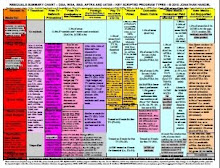One key to understanding Hollywood labor is a tool that was invented thousands of years ago: the calendar. That much became clear in the last round of major negotiations, which lasted from 2007 to 2009, and featured a writers strike and a SAG stalemate. I covered those events as they occurred, and they’re also the topic of my forthcoming book, “Hollywood on Strike!,” which is due out next month.
So with the SAG-AFTRA negotiations upon us, let’s look at what the 2010-2011 bargaining cycle has in store.
SAG and AFTRA
The SAG and AFTRA negotiations with the AMPTP (studio alliance) begin on Monday the 27th, less than a week away. They’ll focus on the SAG Codified basic Agreement (which covers film and television), SAG Television Agreement (a supplement which adds more detail regarding television), and AFTRA’s Exhibit A (which covers primetime scripted television). Exhibit A is largely, though not entirely, composed of cross-references to provisions in the SAG agreements.
These negotiations are under the framework of the Phase I agreement, which has governed SAG-AFTRA joint negotiations with the studios for the last 29 years, with the notable exception of the last negotiating cycle.
On November 7, basic cable negotiations may occur. See http://digitalmedialaw.blogspot.com/2010/09/basic-cable-clarification-details.html for details.
The November 7 date seems to assume that SAG, AFTRA and the AMPTP will reach agreement prior to then. This is expected, but is not a given. The SAG and AFTRA contracts don’t expire until June 30 next year, but the studios insisted on early negotiations in order to reduce the likelihood of brinksmanship, stalemate or strike. This was particularly important to them in light of the nearly year-long SAG stalemate during the last negotiating cycle.
However, timely completion of the contracts seems likely this time because of a seemingly unrelated issue: merger of SAG and AFTRA. The actors—SAG’s leadership in particular—want to spend 2011 working towards merger of the two unions.
That ties the negotiating schedule into the SAG election schedule. SAG president Ken Howard will be up for reelection in the 2011 summer-fall election cycle. In order to best position himself for reelection, it’s important that he and his Unite for Strength faction to show progress on merger prior to the time campaigning begins, which is typically in June or July.
That imperative, in turn, means completing the AMPTP negotiations in November, so that there’s sufficient time to work on merger. The “urge to merge” also has some implications on negotiating issues themselves, as I’ll discuss in a future article.
Of course, one side’s imperative is the other side’s leverage. The AMPTP knows that it’s important for the actors to get their deal done by November, and will be able to hold the unions up against the wall of that deadline if need be. The AMPTP now doubt opposes merger—why would management want to deal with a more unified bargaining representative—and that means they will seek to extract concessions if they’re going to agree to deal points that make merger easier.
DGA
Moving on: In mid-November, the DGA will begin formal negotiation of their film and television agreements, which also expire June 30. Those agreements include basic cable, so there isn’t a separate agreement for that medium as there is for SAG and AFTRA.
The creative rights aspects of the DGA agreements will be negotiated at the same time, but directly with the studio CEOs. This may be the only place in Hollywood labor where negotiation is explicitly reserved to the CEOs, rather than the AMPTP—whose entire purpose is, after all, to negotiate labor agreements.
This extraordinary arrangement reflects both the power of the DGA and the key importance to the guild of maintaining the creative control enjoyed by directors. Or film and TV movie directors, at least. Television series directors march to the tune set by the writer-producer, i.e., the showrunner.
Although the DGA’s formal negotiation don’t start until mid-November, the guild has said they will start informal negotiations prior to then. They may well have done so already. This timing here allows the AMPTP to use the DGA as a shield against SAG-AFTRA contract proposals that the studios consider excessive.
For instance, if the DGA and AMPTP informally agree in September or October that wage increases will be a particular percentage, then if SAG and AFTRA insist on a higher percentage, the AMPTP can demur, confident in the knowledge that they can do a deal with the DGA that will set the pattern on the issue.
Likewise, if the DGA decides that certain new media issues are not important, SAG and AFTRA will have an uphill fight to extract concessions from the AMPTP on those particular issues. Indeed, the DGA has already said publicly that new media will not be a focus of their discussions. So, SAG and AFTRA are already in a difficult place on those issues.
The DGA’s policy of informal pre-negotiations also means that few formal sessions are necessary to reach a deal. Last negotiating cycle, for example, the DGA and AMPTP held just five days of formal bargaining. That’s why this year’s mid-November start date probably means a deal will be reached before Thanksgiving, which falls on November 25th. That allows for roughly 7 weekdays and one weekend of formal sessions.
WGA
And what of the Writers Guild? Those negotiations have not yet been scheduled. They won’t start until mid-January at the earliest, since little business can get done in this industry between Thanksgiving and New Year’s.
That timeframe is a problem, because the WGA usually takes far more than 5 days to reach agreement with the AMPTP. Moreover, their agreement expires two months earlier than the actors’ and directors’, on May 1. That’s a 3-1/2 month window to conduct negotiations.
Such a short window may encourage studios to begin stockpiling feature film scripts later this year, if they haven’t already. That’s because it typically takes two or more months to write and revise such scripts. The studios don’t want to be left with nothing to shoot during the summer, for fear of not having a steady supply of product. Also, early summer is particularly important time for shooting movies that use network television actors, since that’s when they’re on hiatus and thus available for film work.
Television stockpiling, in contrast, probably wouldn’t start until sometime in the spring, as May 1 first approaches.
Writers are aware that this year they’re the caboose and thus are left with little leverage. This may encourage their guild to bargain down to the wire in an attempt to exercise what little power they do have. Thus, the WGA negotiations may turn into a game of chicken, since such brinksmanship is unlikely to translate into a strike authorization, let alone an actual strike, so soon after the devastating 2007-2008 strike.
A middle ground is also possible, which is that the WGA works without a contract for weeks or even months. The dynamics are hard to predict: strike architect David Young is still the union‘s executive director, but the president is now the more moderate John Wells.
Summing Up
In any case, one thing is clear: if SAG and AFTRA are unable to reach a deal by November, the picture looks very different. In this scenario, the DGA will do its deal in November, and then SAG, AFTRA and the WGA will be in play in the spring. This would impede the actors unions’ progress towards merger, but would give SAG, the WGA and AFTRA the ability to threaten a joint strike. Thus, merger and strike threats are at poised against each other quite starkly as contrasting strategies in this negotiating cycle.
Later this week: A look at the issues in play for SAG and AFTRA.
———————
Subscribe to my blog (jhandel.com) for more about entertainment law and digital media law. Check out my residuals chart there too. Go to the blog itself to subscribe via RSS or email. Or, follow me on Twitter, friend me on Facebook, or subscribe to my Forbes.com or Huffington Post articles. If you work in tech, check out my book How to Write LOIs and Term Sheets.

